Top Ten trees of the region
|

Eucalyptus globulus
| 1.Eucalyp (Eucalyptus globulus)
Eucalyptus covers an estimated 60% of the Monchique region. A native of Australia, this drought-tolerant tree looks magnificent when left to grow to full size. However, here the eucalyptus is used as a cash crop for the pulp and paper industry, and consequently is grown as a monoculture and harvested every 8-10 years. This has a devastating ecological impact, lowering the water table, reducing soil quality and diminishing the habitat of local wildlife.
|

Quercus suber
| 2. Cork oak (Quercus suber)
The grand old cork trees of Monchique with their thick trunks and sprawling limbs are the arboreal elephants of this eco-system. The valuable cork bark is skilfully removed from the trunk and branches every 9 years, reducing their possible life span to 200-250 years (they could live up to 600 years). Their ability to regenerate after the severe fires that regularly sweep through the region have made them a part of the native habitat replacing the quercus lusitania that once embodied the ancient Lusitanian landscape. Cork trees have protected status, justifying their economic value and historical importance in the Monchique landscape.
|
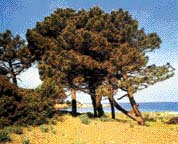
Pinus pinaster
| 3. Mediterranean Pine (Pinus pinaster)
Modern EC forestry policy is promoting the growth of pine in the Mediterranean. A farmer waits approximately 30 years to fell the fast-growing, upright stands. Unfortunately, as a monocultured crop, the potential economic timber value of local pine is offset by its negative ecological impact.
The forests shelter little of the local wildlife, the pine needle beds on the forest floor are an unwelcome and severe fire hazard, and the necessary clearance of local scrub leads to severe soil erosion.
|
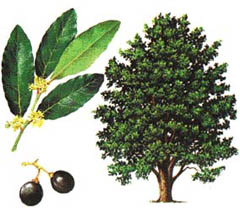
Laurus nobilis
| 4. Laurel (Laurus nobilis)
Individual laurel trees can be found on old fazendos, where their famous leaves are collected to flavour local stews and soups.
|
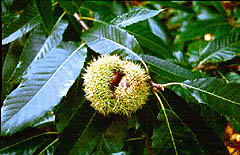
Castanea sativa
| 5. Chestnut (Castanea sativa)
The chestnut tree used to characterise the rural bounty Monchique once offered, giving the region the title of the fruit and vegetable garden of the Algarve. 50 years ago, the centre of Monchique was knee-deep in chestnuts in the October/November harvest. Now a persistent disease and commercial felling have drastically reduced the presence of chestnut trees to a few coppiced stands on the north side of Fóia, but many magnificent individual specimens still grace several old farmsteads.
|
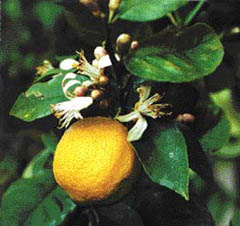
Citrus limon
| 6. Lemon (Citrus limon)
The quintas of Monchique take their form from ancient roman gardens that lent a backdrop to the myths of classical gods shaping destiny against a backdrop of olive trees, citrus fruits, goat's milk and honey. The ancient water systems that keep the lemon farms productive are a part of the master class in conservation and sustainability that the traditional Monchique farmers can demonstrate to the rest of Europe. But EC agricultural policy is not on the side of this last generation of hill farmers, whose citrus fruits will disappear in the crossfire of European agricultural policy.
|
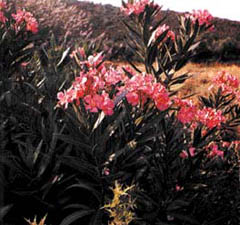
Nerium oleander
| 7. Oleander (Nerium oleander)
The pale pink, rose and white flowers of the oleander add a splash of welcome colour to the brown summer landscape of the Algarve. Native to the Mediterranean, it occurs naturally near dry riverbeds. The oleander has been also been used profusely to landscape roads and gardens, despite its poisonous leaves.
|
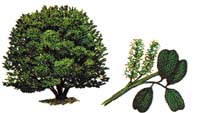
Ceratonia siliqua
| 8. Carob tree (Ceratonia siliqua)
The carob tree offers one of nature's mathematical miracles - every mature seed from the pendulous brown seedpods is identical in weight. Hence its use in Arabic countries as a measure for silver and gold, and the word 'carat'. Now it has a use for the pharmaceutical industry, as part of animal feed, and as a natural alternative to chocolate.
|
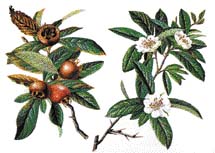
Mespilus germanica
| 9. Nesperas (Mespilus germanica)
The existence of this exotic fruit in Portugal confirms the colonial links that allowed the Portuguese to bring back so many eastern plants to these European shores. Known as the Loquat tree in China, locals here love to have a few ornate specimens near the house, and their delicious small yellow fruits can be eaten in April -June.
|
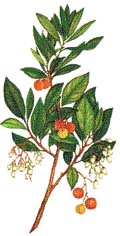
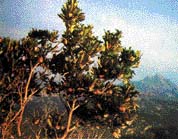
Arbutus unedo
|
10. Medronho (Arbutus unedo)
Commonly known as the strawberry tree, the bright red pulpy fruits are manually harvested for distillation into Medronho, a high ethanol spirit that has kept the locals going for centuries. Medronho wood is excellent for fuel, and the berries can be made into a jam. The bushy Medronho foliage houses a wealth of wildlife, evoking images of a dense and impenetrable African forest canopy.
|
Top Ten Plants
|
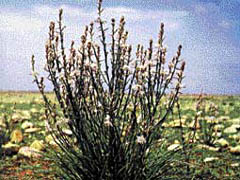
Asphodelus microcarpus
| 1. Affodill (Asphodelus microcarpus)
From March onwards visitors to Monchique can see the tall stems of these giant microcarps preparing to flower. From a broad long leafed base, this is the largest of the asphodels and commonly reaches 1.5 metres. It is a common sight on dry soils, roadsides and the slate rock throughout the Serra.
|
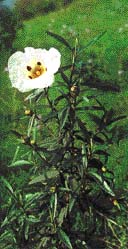
Cistus ladanifer
| 2. Gum Cistus (Cistus ladanifer)
The Cistus characterises the wilderness zones of the Monchique rede 2000. Its beautiful white, purple and yellow flowers dot the green hills of the mato from March or April onwards. The frequent forest fires that sweep through the region regularly feed hungrily on the sticky oily leaves and baked dry stems, but the plant regenerates quickly. Cistus is the important habitat for rabbits, which in turn are the main prey of eagles and bustards circling the valley ridges.
|
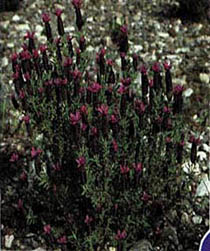
Lavandula stoechas
| 3. Lavender (Lavandula stoechas)
Certain honey from Monchique exudes the fragrance of Lavender nectar collected from March onwards. The incessant buzz of insects in the dry summer heat is part of the experience of walking through the swathes of lavender that proliferate in the rocky soils. A well-known component of aromatherapy, Lavender essence can be purchased in local stores.
|
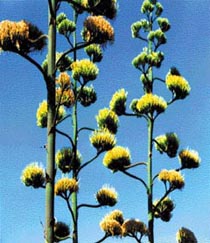
Agave americana
| 4. Sisal (Agave americana)
When in flower, Sisal plants appear on the horizon as sentinels of the wilderness. Those who have seen the commonplace use of sisal in Africa will be reminded of how this part of Europe really has so much in common with the African continent. Known also as the Century Plant, the broad succulent, spiky leaves are useful as cattle hedges or for terrace protection. Their magnificent flowers can reach a record-breaking 6 metres in height, and can be seen in late summer and autumn.
|
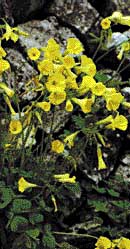
Oxalis pes-caprae
| 5. Bermuda Buttercup (Oxalis pes-caprae)
This lemon-yellow exotic carpets the Algarve each spring. It is typical of how modern ecology evolves with global travel. Originally a native of the African Cape, oxalis was first recorded in the Mediterranean in Sicily in 1796, Malta in 1806, Libya in 1824 and finally in Portugal one year later. Considered a pest in gardens, oxalis propagates via small seeds that colonise soil and cannot be sieved out.
|

Ipomoea Quamoclit vulgaris
|
6. Morning Glory (Ipomoea Quamoclit vulgaris)
Visitors frequently pass roadside hedges entwined by a dense green foliage with a vivid display of purple and blue trumpet shaped flowers throughout the summer. This rampant creeper originated in tropical America, and is capable of 3-4 meters a year growth.
|
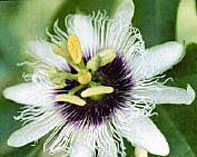
Passiflora edulis
| 7. Passion Fruit (Passiflora edulis)
Traditional quintas are the home of many exotic fruits more usually associated with the tropics than with European climates. Maracuja is often an alternative to using grapevines to provide welcome summer shade. Additionally, the purple egg-shaped fruits of this variety are profuse and delicious. Eaten in late summer, the fruits also make a sweet orange-coloured juice.
|
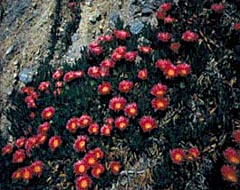
Carpobrotis edulis
| 8. Hottentot Fig (Carpobrotis edulis)
The vivid punk pinks and blazing yellows of these African succulents are now firmly established in the Costa Vicentina and in Monchique, often at the expense of less robust species. Their success of their invasiveness is characterised by intricate and drought toleration mechanisms - their water storage and reproductive strategies enable them to survive in damaged salty or sandy soils. Juice from its leaves have anti-dysentery and anti-septic properties, adding it to the long list of efficacious plants adorning the Algarve.
|
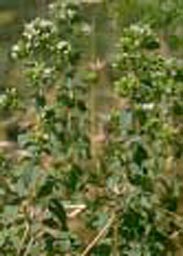
Origanum
| 9. Oregano (Origanum)
Kitchen herbs like basil, thyme, rosemary and oregano are a common feature of the quinta gardens. These herbs provide the flavourings for a range of local dishes, and can be found both in gardens or occurring naturally.
|
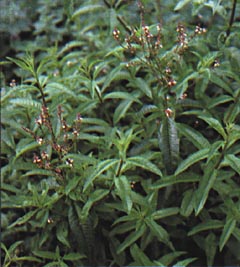
Lippia citriodora
| 10. Lemon Verbena (Lippia citriodora)
Portuguese herb gardens re often complemented by a range of leaves and flowers used as curative teas. Bella Luisa is known for its effect on stomach disorders. This intimate knowledge of nature and the consequent assortment of aromatic garden or wild plants still exists among the elder generation, but as their agricultural life-styles disappear, so will the details of this precious cultural and natural heritage.
|




















